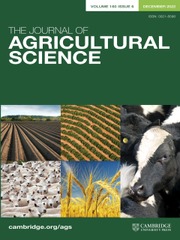Article contents
Effect of herbage in Astrebla spp. pastures in northwest Queensland on lamb survival
Published online by Cambridge University Press: 27 March 2009
Summary
Extensive grazing experiments were conducted over four summer breeding seasons in north-west Queensland between 1984 and 1989. Ewes in the last third of pregnancy were grazed on Mitchell grass (Astrebla spp.) pastures of varying forb (herbaceous plant other than a grass) content. Pastures of low forb content (F-) were attained by stocking paddocks heavily with wethers prior to the experiment, or by selecting paddocks which already contained pastures of low forb content. Pastures of high forb content (F+) were kept without animals prior to the experimental period. Pastures comprised a range of forb biomass (29–828 kg DM/ha) and percentage forbs in total biomass (3–49%). Lamb marking percentage was found to be dependent on the biomass of forbs and proportion of forbs in the pasture, in two experiments. Ewes which grazed F+ pastures had lower lamb marking percentages than those grazing F- pastures.
Twenty pasture species collected during the experiments were analysed for the ratio of 13C: 12C and photosynthetic pathway was determined. Five forb and all three grass species had C4-dicarboxylic acid pathways, ten forbs had Calvin-C3 pathways and two forbs had crassulacean acid metabolism pathways.
Estimates of the proportion of C3 and C4 species in the diet were determined by analysing the ratio of 13C:12C in faeces. The apparent high proportion of Calvin-C3 pathway forbs in the diet of ewes compared to the proportion in the total pasture biomass indicated that ewes preferentially select C3 forbs in the diet, although there was no dependence of lambing percentage on the estimated proportion of C3 forbs in the diet. Management strategies that may improve lambing percentage in the Mitchell grass areas of north-west Queensland are discussed.
Information
- Type
- Animals
- Information
- Copyright
- Copyright © Cambridge University Press 1994
References
REFERENCES
- 3
- Cited by

